By combining several lasers, powers that are unattainable with a single one can be obtained. Purpose: to improve lidars, which are quickly spreading measurement devices.
Zoom in the lab - Issue 55
Lidar is a superb remote analysis tool. Pollutants, wind speed, humidity, turbulence and many objects can be detected by this device using lasers. To improve the performance of lidar, Onera researchers have recently successfully developed a system combining two lasers.
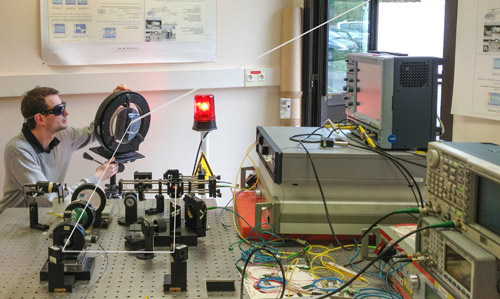
©ONERA
Lidar implementation in the laboratory by coherent combination. In white, a representation of the lidar path, from the source to the atmosphere and back to the sensor (same path)
Lidars are now widely used to monitor wind speed before installing wind farms, orto detect archaeological remains, or to detect wake vortices at airports. Its principle is equivalent to that of radar (lidar is also sometimes called laser radar), using visible light or infrared radiation rather than radar waves. Lidars transmit a powerful laser pulse into the atmosphere, where light interacts with particles and molecules in the air. A fraction of the modified radiation returns to a sensor, where it is analyzed. The speed of the particles can be known, and thus that of the air, thanks to the Doppler effect (the effect explains why the pitch of a siren of a passing by emergency vehicle becomes lower when it drives away).
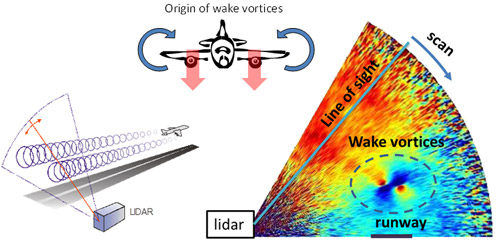
©ONERA
Wake vortices and their characterization over runways using lidar
However, the further away the object to be analyzed, the smaller the fraction of light that returns to the sensor. Thus the range is limited to a few kilometers. In order to gain distance and accuracy, more powerful lasers should be used. However, when using a fiber laser, the useful laser power is limited by the nature of the laserlight itself: beyond a certain power threshold, laser light interacts with the optical fiber along which it propagates. The laser beam quality is degraded by the generation of an acoustic wave on which the light is reflected, damaging the components. Hence the idea of using several laser beams and combining their output to increase the amount of laser radiation produced without increasing the laser power of each laser .
However, superimposing the two beams at the output is not enough. The two waves should also be synchronized so that they merge into one, twice as powerful. In other words, they must be set in phase, as in rowing, where athletes must row rhythmically or lose all effectiveness. Just as oarsmen must have their oars in or out of the water at the same time, the amplitudes of two laser waves must be maximum or minimum at the same time.
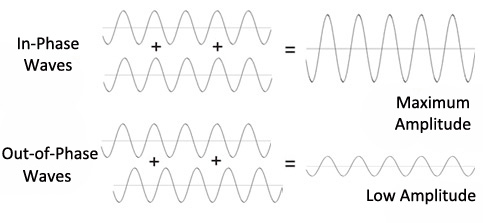
©ONERA
When the amplitudes of both wavesare synchronized, their combination produces the maximum amplitude
To achieve this, the laser beam is first separated into two both waves having thus the same characteristics. Each wave is then amplified while remaining below the power at which the signal is degraded. Finally, the beams are combined and their phase controlled using a device called a phase modulator which advances or delays either of the beams to make them coincide. "This phasing system already existed for continuous laser beams”, says Laurent Lombard, leading this research at Onera. “However, our lidars work with short laser pulses lasting 0.2 to 0.4 microseconds, a time during which light travels only a few hundred meters. These pulses are separated by 100 microseconds, during which it is essential to repeat the correction in order to set the beams in phase again. However, the necessary information for these corrections is only available during the pulses. The trick that we used is to allow a very small amount of laser light to continuously pass through the system so as to permanently control the phase."
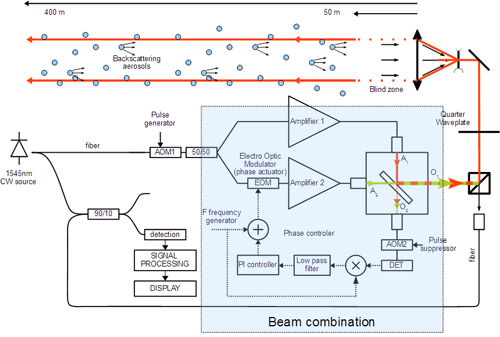
©ONERA
Diagram of a wind speed measurement lidar, based on combined sources. The two signals (50/50 at the outlet) are phase controlled before being amplified and then combined (green and red) and transmitted to the atmosphere.
After a publication outlining the application of this technique to a pulsed laser in 2011, ONERA'sTheoretical and Applied Optics Department implemented it in a lidar and proved that it worked without any degradation of the lidar signal. Before transferring the technology to industry, it must prove that it works at high powers: to date, two 50-Watt continuous lasers have been coherently combined the aim being to achieve two times 500 Watts. Proof of the robustness in a vibrating environment has already been obtained: "we have verified that the servo still works even when a rotary hammer is hitting the optical table”, emphasized Laurent Lombard. These devices are therefore fit to operate onboard an aircraft, for example to measure its speed with respect to air. Such a sensor could backup Pitot tubes that are currently being used but that are not always reliable. They could also be placed onboard a satellite where a powerful laser source is necessary to monitor greenhouse gases from space.
Ultimately, the coherent combination of lasers could pave the way for applications other than lidar, such as surgery, to cut with unprecedented accuracy. Even more futuristic, the Ican project plans to accelerate particles with 10,000 combined lasers!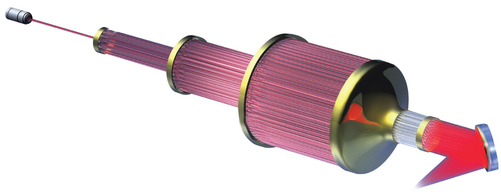
Courtesy of Nature Photonics (The future is fibre accelerators)
Artist's view of the ICAN project coherent combination amplifier, which applications could revolutionize fields such as the nuclear and medical fields.




